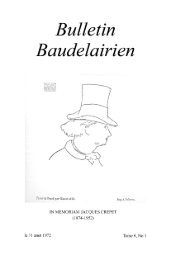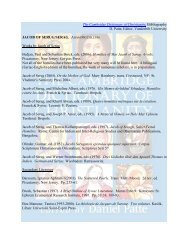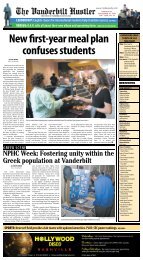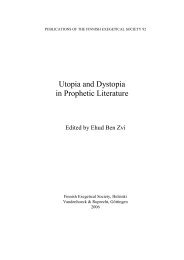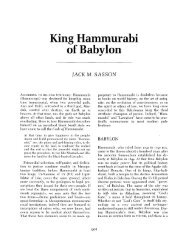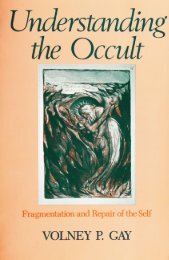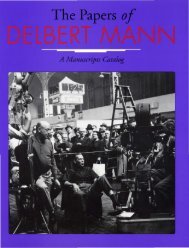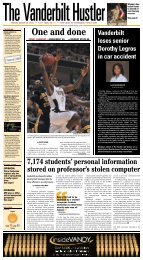From the Editor From the Reader - DiscoverArchive Home ...
From the Editor From the Reader - DiscoverArchive Home ...
From the Editor From the Reader - DiscoverArchive Home ...
Create successful ePaper yourself
Turn your PDF publications into a flip-book with our unique Google optimized e-Paper software.
Ano<strong>the</strong>r fortuitous encounter brought<br />
Mihal into <strong>the</strong> orbit of Chauncey Lowe, a<br />
Chinese art collector who has since contributed<br />
many outstanding pieces to <strong>the</strong><br />
Vanderbilt Asian Art Collection. Mihal was<br />
lecturing in Florida and was introduced to<br />
Lowe after one of his lectures. “Chauncey<br />
invited me to his home, and I almost fell<br />
through <strong>the</strong> floor when I saw his collection,”<br />
says Mihal. This chance meeting has led to<br />
many significant donations of Chinese art<br />
to Vanderbilt, including one of <strong>the</strong> most<br />
important pieces in <strong>the</strong> collection—a magnificent<br />
Ding ware vase from <strong>the</strong> Nor<strong>the</strong>rn<br />
Song dynasty (960–1126).<br />
Because of limited exhibition space, <strong>the</strong><br />
Vanderbilt Asian Art Collection functions primarily<br />
as a student learning resource. “Students<br />
need to be able to handle <strong>the</strong> objects<br />
<strong>the</strong>y are studying,” says Mihal. He provides a<br />
useful analogy: “Let’s say you’re a music student,<br />
and you’re studying a piece of music but<br />
all you have is <strong>the</strong> score. You never encounter<br />
<strong>the</strong> piece firsthand. You need to hear it. Students<br />
need to have a confrontation with <strong>the</strong><br />
original work of art—a one-to-one experience<br />
with something that has been created by<br />
ano<strong>the</strong>r human being.”<br />
Tracy Miller, assistant professor of art history<br />
at Vanderbilt, agrees. “Photographs of<br />
art used in class necessarily flatten objects<br />
from 3-D to 2-D and distort scale. Seeing original<br />
objects is essential to understanding how<br />
an object was made and used. When<br />
students are writing research<br />
papers, we frequently walk<br />
over to <strong>the</strong> gallery and look<br />
at <strong>the</strong> object toge<strong>the</strong>r. We<br />
take out a magnifying glass and<br />
examine <strong>the</strong> brushwork or <strong>the</strong><br />
marks left from carving. This<br />
is impossible to do with reproductions.”<br />
Accordingly, a por-<br />
Left: Horoshige’s color wood-block<br />
print “A Pilgrims’ Association<br />
Procession at Kanasugibashi at<br />
Shibaura,” from <strong>the</strong> Anna C. Hoyt Collection;<br />
upper left: <strong>the</strong> 18th-century Japanese Suzuribako<br />
(writing case) is made of lacquer with gold<br />
and silver; above: <strong>the</strong> Western Han dynasty<br />
(206 BCE–9 CE) “Horse with Rider” was a gift<br />
from Chauncey P. Lowe; upper right: a Ming<br />
dynasty (1368–1644) Bodhisattva<br />
tion of <strong>the</strong> Vanderbilt University Fine Arts<br />
Gallery is permanently dedicated to <strong>the</strong> needs<br />
of students. Every semester, Mella coordinates<br />
exhibits with professors to ensure that syllabuses<br />
and exhibits are closely integrated.<br />
The Asian Art Collection also does much<br />
to enhance Vanderbilt’s profile on <strong>the</strong> world<br />
stage. “As a top-tier research university, it is<br />
beneficial for Vanderbilt to support research<br />
and teaching about Asia, which contains<br />
almost two-thirds of <strong>the</strong> world’s population,”<br />
says Miller. Having objects<br />
from <strong>the</strong> Asian Art Collection available<br />
for viewing “enriches and<br />
broadens <strong>the</strong> perspectives<br />
of students as<br />
well as public viewers,”<br />
she continues. “As <strong>the</strong><br />
collection grows, its<br />
original works of art will<br />
also become <strong>the</strong> subject<br />
of research by outside scholars,<br />
who will fur<strong>the</strong>r contribute<br />
to <strong>the</strong> intellectual diversity of <strong>the</strong><br />
College of Arts and Science and<br />
Vanderbilt as a whole.”<br />
Singling out o<strong>the</strong>r<br />
highlights from a collection<br />
of this quality<br />
and size is no easy<br />
task; <strong>the</strong> collection is<br />
broad and deep and<br />
includes ceramics, woodblock<br />
prints, lacquer-ware, sculpture,<br />
paintings, calligraphy scrolls, illustrated<br />
books, artists’ notebooks, jades, bronzes,<br />
textiles, textile stencils (tough paper coated<br />
with persimmon juice—works of art<br />
in <strong>the</strong>mselves), and many o<strong>the</strong>r<br />
Asian artifacts. One of <strong>the</strong> most<br />
striking pieces in <strong>the</strong> Asian Art<br />
Collection is a Ming dynasty-era<br />
(1368–1644), painted terra-cotta<br />
statue of a Bodhisattva, which<br />
dominates <strong>the</strong> rear of <strong>the</strong> Fine<br />
Arts Gallery. O<strong>the</strong>r notable pieces<br />
include an Indian statue of Vishnu, a<br />
remarkable six-panel screen from <strong>the</strong> Japanese<br />
Tosa School depicting <strong>the</strong> 10th-century<br />
Tale of Genji (purportedly <strong>the</strong> first novel ever<br />
written), a rare Tang dynasty-era (618–907)<br />
head of Buddha, an exquisite Japanese<br />
portable writing set (which Mella describes<br />
as “<strong>the</strong> laptop of its day”), and color woodblock<br />
prints by Munakata Shiko (1903–<br />
1975), who is generally considered to be one<br />
of <strong>the</strong> most significant Japanese artists of <strong>the</strong><br />
20th century.<br />
The collection, highlights of which are<br />
regularly shown in <strong>the</strong> Vanderbilt University<br />
Fine Arts Gallery as part of larger <strong>the</strong>matic<br />
exhibitions, offers fascinating perspectives<br />
into Asian history, religious beliefs and society.<br />
In doing so it forms an important cultural<br />
bridge between Vanderbilt and <strong>the</strong> wider<br />
world, and an artistic bridge between traditional<br />
Western aes<strong>the</strong>tic sensibilities and <strong>the</strong><br />
sublimities and economical beauties of Asian<br />
art making.<br />
Paul Deakin writes about <strong>the</strong> visual arts and music<br />
for numerous publications. He is a lecturer in music<br />
<strong>the</strong>ory at <strong>the</strong> Blair School of Music.<br />
V a n d e r b i l t M a g a z i n e<br />
23



